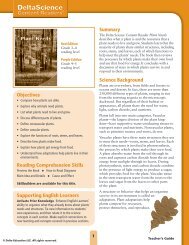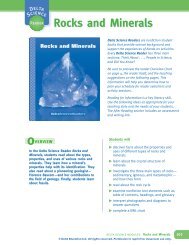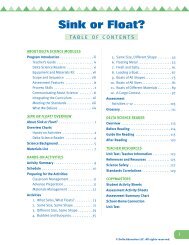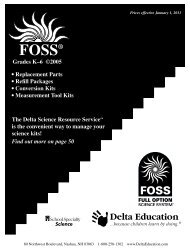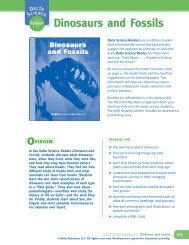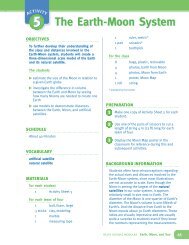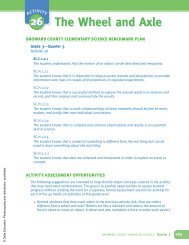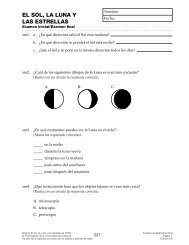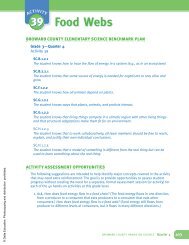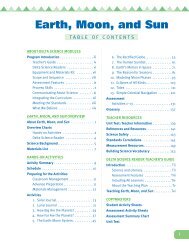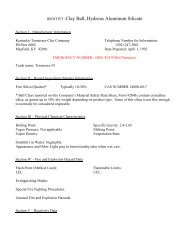Simple Machines -Teacher's Guide Table Of ... - Delta Education
Simple Machines -Teacher's Guide Table Of ... - Delta Education
Simple Machines -Teacher's Guide Table Of ... - Delta Education
Create successful ePaper yourself
Turn your PDF publications into a flip-book with our unique Google optimized e-Paper software.
<strong>Simple</strong> <strong>Machines</strong>T ABLE OFCONTENTSABOUT DELTA SCIENCE MODULESProgram Introduction . . . . . . . . . . . . . . . . . . . iiiTeacher’s <strong>Guide</strong> . . . . . . . . . . . . . . . . . . . . . iv<strong>Delta</strong> Science Readers. . . . . . . . . . . . . . . . viEquipment and Materials Kit . . . . . . . . . . viiScope and Sequence. . . . . . . . . . . . . . . . viiiAssessment Features. . . . . . . . . . . . . . . . . ixProcess Skills . . . . . . . . . . . . . . . . . . . . . . . xCommunicating About Science. . . . . . . . . xiIntegrating the Curriculum . . . . . . . . . . . . xiiMeeting the Standards . . . . . . . . . . . . . . xiiiWhat We Believe . . . . . . . . . . . . . . . . . . . xivSIMPLE MACHINES OVERVIEWAbout <strong>Simple</strong> <strong>Machines</strong> . . . . . . . . . . . . . . . . . . 1Overview ChartsHands-on Activities . . . . . . . . . . . . . . . . . . 2<strong>Delta</strong> Science Reader . . . . . . . . . . . . . . . . 4Science Background. . . . . . . . . . . . . . . . . . . . . 5Materials List . . . . . . . . . . . . . . . . . . . . . . . . . . 7HANDS-ON ACTIVITIESActivity Summary . . . . . . . . . . . . . . . . . . . . . . . 9Schedule . . . . . . . . . . . . . . . . . . . . . . . . . . . . . 10Preparing for the ActivitiesClassroom Management . . . . . . . . . . . . . . 11Advance Preparation . . . . . . . . . . . . . . . . . 11Materials Management . . . . . . . . . . . . . . 12Activities1. Doing Work. . . . . . . . . . . . . . . . . . . . . . 132. Levers . . . . . . . . . . . . . . . . . . . . . . . . . . 193. Friction . . . . . . . . . . . . . . . . . . . . . . . . . 254. Inventing the Wheel . . . . . . . . . . . . . . 335. The Wheel and Axle. . . . . . . . . . . . . . . 396. Tractor Traction . . . . . . . . . . . . . . . . . . 497. Gears . . . . . . . . . . . . . . . . . . . . . . . . . . 578. Pulleys . . . . . . . . . . . . . . . . . . . . . . . . . 659. Inclined Planes. . . . . . . . . . . . . . . . . . . 7110. Wedges . . . . . . . . . . . . . . . . . . . . . . . . 7711. Screws . . . . . . . . . . . . . . . . . . . . . . . . . 8312. Domestic <strong>Simple</strong> <strong>Machines</strong>. . . . . . . . . 91AssessmentActivities 1–12 . . . . . . . . . . . . . . . . . . . . . . 97Glossary . . . . . . . . . . . . . . . . . . . . . . . . . . . . 103DELTA SCIENCE READEROverview . . . . . . . . . . . . . . . . . . . . . . . . . . . . 105Before Reading . . . . . . . . . . . . . . . . . . . . . . . 106<strong>Guide</strong> the Reading . . . . . . . . . . . . . . . . . . . . 107After Reading. . . . . . . . . . . . . . . . . . . . . . . . . 114TEACHER RESOURCESUnit Test: Teacher Information . . . . . . . . . . 117References and Resources. . . . . . . . . . . . . . 119Science Safety. . . . . . . . . . . . . . . . . . . . . . . . 121Standards Correlations . . . . . . . . . . . . . . . . 123COPYMASTERSStudent Activity SheetsAssessment Activity SheetsAssessment Summary ChartSchool-Home ConnectionUnit Test© <strong>Delta</strong> <strong>Education</strong> LLC. All rights reserved.i
About <strong>Simple</strong> <strong>Machines</strong><strong>Delta</strong>ScienceModules, THIRD EDITIONStudents explore <strong>Simple</strong> <strong>Machines</strong> with twelve hands-onactivities and the <strong>Delta</strong> Science Reader. By measuring forceas they lift, push, and pull loads, your class will determinethe mathematical relationship between force and work.Students build and/or operate classroom versions of thesix simple machines: lever, wheel and axle, pulley, inclinedplane, wedge, and screw. They investigate how (andhow much) each one makes work easier by magnifying,modifying, transferring, or changing the direction of theapplied force. By calculating such factors as gear ratiosand the negative effects of friction, students discover thetradeoff between force and distance. Students also identifyand examine household or other everyday simple machines.In the <strong>Delta</strong> Science Reader <strong>Simple</strong> <strong>Machines</strong>, studentsexplore the world of simple machines and the energythat makes them work. Students read about the six simplemachines—the inclined plane, the lever, the wheel andaxle, the pulley, the wedge, and the screw—and understandthe difference between simple and compound machines.In biographical sketches, students meet ancient Greekmathematician Archimedes and modern inventor LillianGilbreth, and discover how they put simple machines towork. Students also read about the scientific formula forcalculating work, the many levers in the human body, andhow a roller coaster works.<strong>Simple</strong> <strong>Machines</strong> 1© <strong>Delta</strong> <strong>Education</strong> LLC. All rights reserved.
Overview Chart for Hands-on Activities1Hands-on ActivityDoing Workpage 132 Leverspage 193Frictionpage 254 Inventing the Wheelpage 335The Wheel and Axlepage 396 Tractor Tractionpage 497Gearspage 578 Pulleyspage 659Inclined Planespage 7110 Wedgespage 7711Screwspage 8312 Domestic <strong>Simple</strong><strong>Machines</strong>page 91Assessmentpage 97Student Objectives• measure the force required to move an object• measure the distance the object was moved• calculate how much work was done when the object was moved a measured distance• construct a lever• investigate the mechanical advantage of a lever by experimenting with theposition of the fulcrum, load, and effort• observe the effects of friction• examine variables that increase and decrease friction• discover one method of reducing friction• measure the amount of force needed to move an object a certain distance• predict how using wheels will affect the amount of force needed to move thatsame object the same distance• observe how even the most primitive wheels reduce the amount of force neededto move an object, and thereby the amount of work performed• assemble a tractor• investigate the transfer of force between the axles and the wheels of the tractor• discover the mechanical advantage of a wheel and axle simple machine• discover how traction affects the forward motion of a rotating object• discover how friction affects the distance a rotating object will travel• examine the structure of a gear• observe how gears interact to transfer force• discuss gear ratio• construct a simple pulley• measure the force required to lift an object, with and without the use of a pulley• observe that a pulley reverses the direction of applied force• measure the amount of force needed to do a given amount of work, with andwithout the use of an inclined plane• discover how an inclined plane enables them to use less force to do about thesame amount of work by distributing the force over a greater distance• observe the use of inclined planes in wedges• use a wedge to perform work• observe how wedges make doing work easier• build a model of a screw by wrapping an inclined plane around a cylinder• compare the force used to drive a screw with that used to drive a nail• discuss how screws make work easier• identify examples of simple machines found in the home• discuss the features of these household devices that make them simple machines• design and construct a mobile• See page 97.2 delta science modules© <strong>Delta</strong> <strong>Education</strong> LLC. All rights reserved.
Process Skillsmeasure, compare, usenumbers, collect dataVocabularyforce, joule, newton, work<strong>Simple</strong> <strong>Machines</strong><strong>Delta</strong> ScienceReaderpages 2, 3make and use models, inferarm, effort, fulcrum, lever, load, machine,mechanical advantage, simple machinepages 5–6, 14observe, use variables, inferfriction, lubricantpage 2measure, predict, observewheelpages 7, 10, 15make and use models,predict, inferaxlepage 7predict, measure, infertractionpages 2, 11observe, communicatedriven gear, driving gear, gear, gear ratiopages 10–11make and use models, measure,observepulleypages 8, 10, 15measure, inferinclined plane, ramppage 4observe, make and use modelswedgepage 9make and use models, compare,measure, communicatescrew, threadpages 9, 12classify, communicate, make anduse modelsmobilepage 4See the following page for the <strong>Delta</strong>Science Reader Overview Chart.<strong>Simple</strong> <strong>Machines</strong> 3© <strong>Delta</strong> <strong>Education</strong> LLC. All rights reserved.
Overview Chart for <strong>Delta</strong> Science Reader<strong>Simple</strong> <strong>Machines</strong>SelectionsThink About...What Makes Things Move?page 2Vocabularyforce, friction, gravity, inertia, motion,newton, speedRelatedActivity1How Are Work and Energy Related?page 3distance, energy, joule, kinetic energy,potential energy, work1, 3What Are <strong>Simple</strong> <strong>Machines</strong>?• Inclined Plane• Lever• Wheel and Axle• Pulley• Wedge• Screwpages 4–9What Are Compound <strong>Machines</strong>?page 10People in Science• Archimedespage 12• Lillian Gilbrethpage 13Did You Know?• Your Body Has Leverspage 14• How a Roller Coaster Workspage 15efficiency, effort, fulcrum, inclined plane,lever, machine, pulley, resistance, screw,simple machine, wedge, wheel and axlecompound machine2, 4, 5, 6, 7,8, 9, 10, 1112228See pages 105–115 for teaching suggestionsfor the <strong>Delta</strong> Science Reader.4 delta science modules© <strong>Delta</strong> <strong>Education</strong> LLC. All rights reserved.
M ATERIALS LISTQuantity Description Quantity Description8. . . . . . . . bricks, half†16 . . . . . . . . cups, plastic40 . . . . . . . . dowels1. . . . . . . . fishing line, 100 m8. . . . . . . . fulcrums8. . . . . . . . gear bases1. . . . . . . . gear cover8. . . . . . . . gear handles8. . . . . . . . gear pointers8. . . . . . . . gears, large8. . . . . . . . gears, medium8. . . . . . . . gears, small24 . . . . . . . . hex nuts1. . . . . . . . nails, p/64*4. . . . . . . . paper clips, p/1008. . . . . . . . pegboard beams1. . . . . . . . petroleum jelly, 1 oz*8. . . . . . . . pulleys8. . . . . . . . rivets*1. . . . . . . . rubber bands, long, p/251. . . . . . . . rubber bands, short, p/251. . . . . . . . rubber bands, wide, p/258. . . . . . . . sandpaper, sheets*32 . . . . . . . . screws*8. . . . . . . . spring scales1. . . . . . . . string, 129 m*1. . . . . . . . tape, masking*1. . . . . . . . thread*8. . . . . . . . tractor kits16 . . . . . . . . waxed paper, 30 cm × 30 cm*8. . . . . . . . wooden boards†1. . . . . . . . Teacher’s <strong>Guide</strong>8. . . . . . . . <strong>Delta</strong> Science Readers<strong>Simple</strong> <strong>Machines</strong>TEACHER-PROVIDED ITEMS32 . . . . . . . . books8. . . . . . . . hammers1. . . . . . . . hole punch8. . . . . . . . index cards, 3 in. × 5 in.8. . . . . . . . markers, wide8. . . . . . . . metersticks8. . . . . . . . paper, sheets*–. . . . . . . . paper towels*8. . . . . . . . pencils8. . . . . . . . rulers, metric32 . . . . . . . . safety goggles8. . . . . . . . scissors8. . . . . . . . screwdrivers, flat-slot8. . . . . . . . wood, scraps** = consumable item † = in separate boxTo order consumable items or refill kits, please call 1-800-442-5444.<strong>Simple</strong> <strong>Machines</strong> 7© <strong>Delta</strong> <strong>Education</strong> LLC. All rights reserved.
ACTIVITY SUMMARYThis <strong>Delta</strong> Science Module begins aninvestigation of simple machines byintroducing students to the concepts of forceand work.ACTIVITY 1 Students determine the amount offorce necessary to move objects. Then theylearn how to calculate the amount of work donewhen an object is moved over a measureddistance.ACTIVITY 2 Students examine the lever, thefirst of six types of simple machines. Theyconstruct a lever and discover the mechanicaladvantage of this device: that they can move anobject with less effort simply by repositioningthe fulcrum.ACTIVITY 3 Students examine friction—thenumber-one enemy of machines. They observehow friction increases the amount of forcenecessary to move objects and do work. Theyalso experiment with surfaces that producevarying degrees of friction, as well as observeone method of reducing friction.ACTIVITY 4 Students discover how even themost primitive wheels reduce the amount offriction between an object and the surface overwhich it moves, thereby reducing the amount offorce necessary to move the object.ACTIVITY 5 Students continue theirexamination of the wheel and are introduced toanother simple machine—the wheel and axle.While experimenting with a tractor, theydiscover that force is transferred between theaxle and the wheel and the tractor moves.Taking a closer look at the forces involved, theysee that force is decreased when transferredfrom the axle to the wheel (as in the tractor)and magnified when transferred from the wheelto the axle (as in a screwdriver). They thenexamine a screwdriver to see how it makes useof this mechanical advantage.ACTIVITY 6 Students discover that friction canbe useful. They experiment with traction(moving friction) and how it improves theperformance of their tractors.ACTIVITY 7 Students look at a special type ofwheel called a gear. They examine the structureof a gear and observe how force that is appliedto a driving gear is transferred to a driven gear.They discuss gear ratio and how it affects thedistance each gear will move.ACTIVITY 8 Students examine a third type ofsimple machine: the pulley. They observe how apulley redirects applied force, enabling them tolift an object by pulling down on a string.ACTIVITY 9 Students conduct an investigationof inclined planes—a fourth type of simplemachine. They perform experiments anddiscover that the inclined plane allows them todo the same amount of work while exertingless effort.ACTIVITY 10 Students discuss the properties ofthe wedge that enable it to be classified as afifth type of simple machine. They discover thata wedge is comprised of two or more inclinedplanes positioned to form a point, and that thetip of a nail is actually a wedge, which makes iteasier to drive into wood than a blunt-endedrivet.ACTIVITY 11 Students examine the screw—asixth type of simple machine. Students discoverthat a screw consists of an inclined planewrapped around a cylinder. They compare therelative force used to drive a screw with thatused to drive a nail, and discover how screwsmake work easier.ACTIVITY 12 Students compare lists of simplemachines found in the home. They then build amobile from dowels.9<strong>Simple</strong> <strong>Machines</strong> 9© <strong>Delta</strong> <strong>Education</strong> LLC. All rights reserved.



